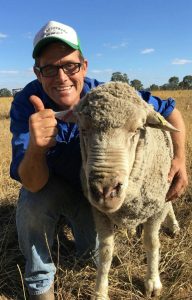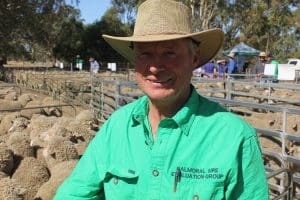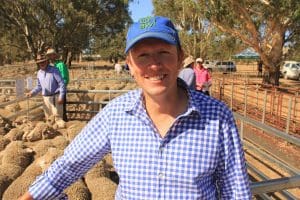
Harrow wool grower Michael Craig has a Merino ram dubbed Barnaby.
A YOUNG poll Merino ram dubbed Barnaby has made a name for himself in a ewe flock at Harrow, in Victoria’s Western District.
The flock at Michael and Jane Craig’s Tuloona property is one of five providing the ewes for the $13 million national Merino Lifetime Productivity Project – Australia’s largest sire evaluation trial.
Last Friday at Tuloona, hundreds of wool growers flocked to inspect more than 1800 ewes yarded in sire progeny groups and listen to industry speakers.
The 10-year project has been set up to test the reliability of traditional visual classing and new genetic selection methods by joining 137 rams to about 5500 ewes and evaluating progeny in the five host Merino flocks in Victoria, New South Wales and Western Australia.
The Australian Wool Innovation-funded project is a $7 million (plus $4 million in support from project partners), 10-year partnership between AWI, the Australian Merino Sire Evaluation Association, nominating stud breeders and the site hosts.
As part of the project, Barnaby the three-year-old ram was among 11 Tuloona AI-bred rams joined naturally to 584 2015-drop MLP ewes to generate 482 (F2) lambs.
And just as his namesake in the federal National Party has led to a re-assessment of the Coalition’s code on MP-staff relations, Barnaby the ram illustrated one aspect of the MLP project’s potential to re-write ram assessment criteria for the nation’s Merino flocks.
AMSEA executive officer Ben Swain said DNA testing to identify the sire of each lamb produced by the ram syndicate-mated ewes showed that the ram generated 33pc of the lambs, while a counterpart sired just one percent.
“This is an actual range from 6 lambs to 164 lambs.
“There is a joke in there about Barnaby, but I’m not sure if it is appropriate – he used to be my local member, not anymore,” he said.
“What will be fascinating, this bloke here, is he going to do the same thing next year?
Also one ram in the group produced lambs 5kg lighter than the others at weaning.
“They were runts compared to the rest of the weaners,” Mr Swain said, but their sire wasn’t Barnaby.
“No it wasn’t, it’s a shame isn’t? It would have been good if it was … I could make it up that it was, then Michael could go and sack him.”
“He produced above average lambs, so he’s a ripper; he produced heaps of lambs and they’re pretty good, so you can keep him,” Mr Swain said.
“What will be interesting is if he does the same next year.
“If that stuff is repeatable, what a huge impact that has on commercial wool-growing,” he said.
“It’s not so good on stud breeding of course because you don’t need as many of them.
“Is there a gene in there that that ram possesses that makes him just such a goer, or did he just have a good year, is he just a bully?”
Mr Craig said the ram would probably be joined next year to “see if he does it again.”
Mr Swain also said there were 92 sets of twin lambs – 184 lambs — tagged in the syndicate-mated ewes.
“Thirty six percent of those sets of twin lambs had a different sire – so those twin lambs were half-siblings.
“So your mother is your mother and your mother had two husbands at the same time, which generated twin lambs that have got different dads … ,” he said.
“And you know who was the main culprit, siring half those (twin) lambs? It was Barnaby himself, that ram.”
“DNA opens up huge opportunities up to tease this stuff out – because your daddy may not be who you think your daddy is, or who your mummy thinks your daddy is or may not be the same as your twin sister.”
Huge spread in teeth eruption
Mr Swain said teeth eruption is a major profit driver of any Merino enterprise turning off lambs for meat marketing, so this was measured in the lambs from the sire groups at Tuloona as an “add-on” project.
At 13 months of age all lambs still had their lambs’ teeth and by 18 months all had erupted their two permanent teeth.
“But there was this huge spread at 14 months where some sire groups (progeny) were still lambs and more than half of other sires group (lambs) had cut their teeth.”
Mr Swain said growers might assume that the early maturing lambs cut their teeth earlier, but this was not the case, with little difference in the weight of all lambs at 14 months.
“So it is not as though the guys who are two-tooths are 10 kgs heavier, they’re actually all pretty much the same weight.
“If that’s what happens in commercial flocks, it’s a big difference in profitability.”
Mr Swain said he saw MLP as being about the relationship between all the different traits that sheep breeders like that give them good wool-cutting ewes rearing lots of lambs with good carcases and not many culls.
Longevity difference in ewe progeny

Former Balmoral Sire Evaluation Group chairman Tom Silcock.
Former Elders Balmoral Sire Evaluation Group chairman Tom Silcock said the MLP project is about making more money and breeding better sheep.
“What we are starting to see is that there is quite a big difference across the sires now in the longevity or death rates of their F1 ewes – one sire has lost none and another sire has lost 20pc.
“Is there a linkage in there with fat and muscle or is it related to worm issues? I don’t know.
“What it does is whet out appetite for what potentially we might discover and some of the things that we thought might be important….” he said.
“The biggest conception rates don’t necessarily give you the most lambs on the ground; it’s the numbers of lambs weaned or more importantly kilograms of lambs weaned to kilograms of ewes joined.”
Mr Silcock said there are more questions than answers at this stage in the trial.
“But we are just seeing enough to whet our appetite.”
He was particularly interested in the repeatability in breeding indexes for the sires as their progeny grew, with the progeny from one ram showing an increase in wool quality with age. He is hoping the trial will provide the information to give greater reliability to genomic predictions and Australian Sheep Breeding Values for wool, carcase, reproduction and worm resistance traits.
“We want to roadtest all these breeding values to see how accurate and predictable they really are and what makes them accurate and predictable and what doesn’t.”
Mr Silcock said he also wanted to compare the teeth longevity in sheep and compare this to eruption in the ewes as lambs.
“We’re doing the same on the teats, because the teats are going to fall over on us too.”
Big range in maternal ewe efficiency

AMSEA executive officer Ben Swain.
Mr Swain said maternal efficiency — kg of lambs weaned by kg of ewes joined – is an important profit driver for the Merino industry wanting cost-efficient ewes, producing as many lambs as possible. But early results for the 2015-drop ewes at Harrow were showing a massive range between 50-70pc.
“The ewes from the top ram produced 69 percent of their weight in lambs, the bottom produced 50pc.
“That’s a massive range, if you’ve got a flock of 10,000 ewes, even a 1000 or even 100 ewes and you were getting a 20pc increase in the number of kgs of lamb produced at weaning…”
But he said it was very early days in the trial and the project had only collected 2pc of the potential data on reproduction.
“We’ve collected data on less than 500 lambs, we’re going to collect data on 25,000.”
Mr Swain said there was also a massive range in the litter size of among ewes joined at Tuloona; from 68-149 lambs.
AWI’s Geoff Lindon said in his lifetime, in the Merino industry, rams had progressively been sold at younger ages — from 20 months to 12-13 months of age.
“There is talk in the industry that we can even take the age of classing even younger.
“In terms of the genetic advice that we get, overwhelmingly they say that you need one adult fleece weight or value and you need to do reproduction for their lifetime to get a good handle on the lifetime profitability of the animal.
“But in essence the industry has moved the other way — we’ve gone younger and younger and younger — and there is very little adult fleece weight measurement being done and there is a low number of reproduction records on offer – so hence the importance of this project; to try to increase the amount of data being taken and to really understand how valuable, how important are these measurements at the older age.”
Mr Lindon said the project is also looking at the balance between relative selection for wool and carcase traits and between visual and objective assessment.
“Clearly when you multiply a small increase in the lifetime profitability of these animals across 18-20 million ewes, that is why it is a priority within AWI
Mr Lindon said there was a broad diversity of sires entered in the MLP project at the request of organisers seeking specific traits.
“The trial really is about what is the right mix of traits and how do we assess the lifetime productivity using these traits at a young age.”
Time for group hugs in the Merino industry
MLP project manager Anne Ramsay said industry has a lot of questions about the current selection system.
“There are some concerns that we are using a lot of different selection systems and selecting our animals at a younger and younger age
“And there are concerns how does this early life performance relate to lifetime performance,” she said.
“I guess it is time for us to check in on our selection systems — no matter what they are — and see how effective they are at delivering lifetime performance.
“Maybe along the way we will learn a few new tips and tools that we can incorporate into our existing selection systems – no matter what approach you use – so that we can deliver better lifetime performance no matter what genetics you have and no matter where you are.”
Ms Ramsay said one of the greatest things about the project is that it is all about bringing the industry together and raised the prospect of working together to exceed the productivity of competing industries.
“There are a lot of ram breeders out there that use all sorts of different approaches, but we are all in this tent together and I think the Merino industry needs to do a lot more group hugs.”
“The project is all about creating big data, so that we can better understand how effective our current selection systems are and finetune them so that we can deliver lifetime productivity for all Merinos no matter what type, bloodline or environment.”
Click here for the Balmoral field day report and the 2015 and 2016 drop results.

Sheep breeders, no matter what the breed, need to measure productivity and performance.
I believe it important to understand the key profit drivers relating to the breeding ewe and her progeny so each sheep enterprise becomes more efficient in managing its production systems. If we monitor breeding ewes and their performance then only productive ewes need to be kept on farm. It is as simple as that.